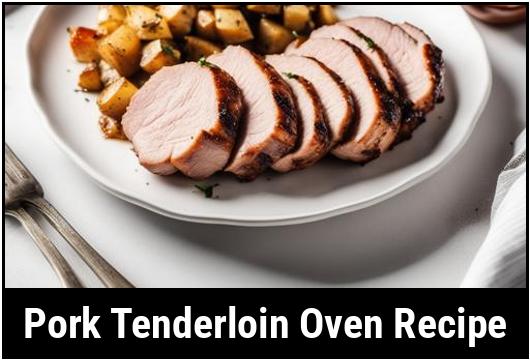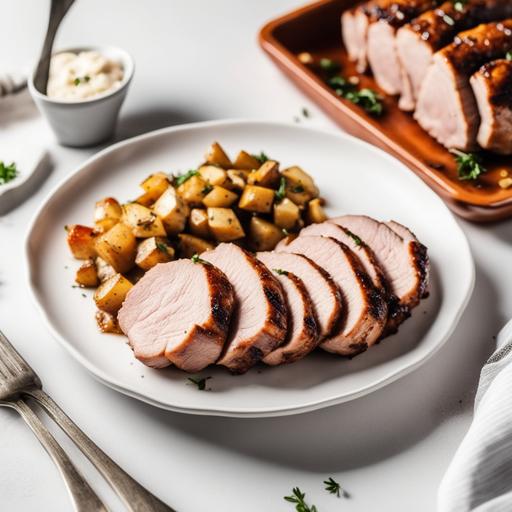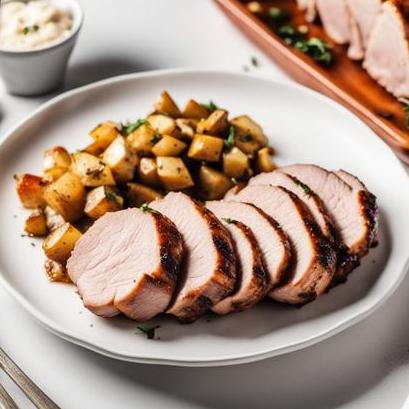
Pork Tenderloin Oven Recipe: A Culinary Delight
Are you in the mood for a succulent and juicy pork tenderloin that melts in your mouth? Look no further! In this comprehensive guide, we will explore the art and science of cooking the perfect pork tenderloin in the oven. From selecting the right cut to checking for doneness, we’ve got you covered. So roll up your sleeves, let’s get cooking!
Understanding the Science behind Pork Tenderloin
Before we dive into the details of preparing a mouthwatering pork tenderloin, let’s take a moment to appreciate the science behind this delectable cut of meat. Pork tenderloin comes from a muscle that runs alongside the backbone of the pig. It is known for its tenderness and mild flavor, making it a popular choice among meat enthusiasts.
One of the key reasons for its tenderness is the lower content of connective tissue compared to other cuts. This makes pork tenderloin cook faster, but also requires careful attention to prevent overcooking, which can cause dryness.
Selecting the Perfect Cut of Pork Tenderloin
The first step towards a successful pork tenderloin oven recipe is selecting the right cut. Here are a few tips to help you choose the perfect pork tenderloin:
-
Look for firm and pale pink meat with a small amount of marbling. Avoid cuts that appear discolored or have excessive fat.
-
Opt for tenderloins that are about 1 to 1.5 pounds each. This size ensures even cooking and allows for a juicy interior.
-
If possible, choose pork tenderloin that has been labeled as "all-natural" or "organic" for a higher quality and more flavorful result.
Cleaning and Preparing the Pork Tenderloin

Now that you have selected your ideal cut of pork tenderloin, it’s time to prepare it for cooking. Follow these steps for proper cleaning and preparation:
-
Start by rinsing the pork tenderloin under cold running water to remove any bone fragments or loose bits of meat. Pat it dry using paper towels.
-
Trim off any excess fat or silver skin. Removing the silver skin helps prevent the meat from curling while cooking and ensures even heat distribution.
-
Optional: Marinate the pork tenderloin if desired. A simple marinade can add flavors and tenderize the meat further. Consider using ingredients like garlic, herbs, soy sauce, or citrus juices.
Tips for an Exquisite Pork Tenderloin Oven Recipe
Preparing a pork tenderloin in the oven requires attention to detail. Here are some essential tips to elevate your recipe to new heights:
-
Seasoning: Liberally season your pork tenderloin with salt and freshly ground black pepper before cooking. This enhances the natural flavors and creates a delightful crust.
-
Tying: To maintain an even shape during cooking, consider tying the pork tenderloin with kitchen twine. This helps it cook evenly and prevents it from drying out.
-
Searing: For an extra burst of flavor, sear the pork tenderloin in a hot skillet before transferring it to the oven. Searing helps to lock in the juices and adds a beautiful caramelized exterior.
Variations to Explore
While a classic pork tenderloin oven recipe is delicious on its own, there are numerous variations that can take your culinary adventure to the next level. Here are a few ideas to inspire your creativity:
-
Stuffed Pork Tenderloin: Create a pocket in the pork tenderloin and stuff it with ingredients like cheese, spinach, or mushrooms. This adds layers of flavor and surprises with every bite.
-
Asian-inspired Glaze: Prepare a glaze using ingredients such as soy sauce, honey, ginger, and garlic. Brush it onto the pork tenderloin during the cooking process for an irresistible sweet and savory combination.
-
Fruit Pairings: Enhance the natural sweetness of pork tenderloin by pairing it with fruit like apples, peaches, or cranberries. Roast the fruit alongside the pork for a harmonious blend of flavors.
Checking for Perfect Doneness

Knowing when your pork tenderloin is perfectly cooked is crucial to ensure a memorable dining experience. Here are some indicators to help you achieve the desired level of doneness:
-
Internal Temperature: Use a reliable meat thermometer to check the internal temperature of the pork tenderloin. For a medium doneness, aim for 145°F (63°C). Be careful to avoid overcooking, as the tenderloin can quickly become dry.
-
Resting Time: After removing the pork tenderloin from the oven, allow it to rest for about 5-10 minutes before slicing. This allows the meat to reabsorb its juices, resulting in a moist and tender final texture.
A Lip-Smacking Pork Tenderloin Oven Recipe
Now that you have all the essential knowledge, it’s time to embark on the flavorful journey of cooking a mouthwatering pork tenderloin in the oven. Here’s a recipe that will leave your taste buds longing for more:
Ingredients:
-
2 pork tenderloins, approximately 1-1.5 pounds each
-
Salt and freshly ground black pepper to taste
-
2 tablespoons olive oil
-
Optional marinade or seasoning to taste
Instructions:
-
Preheat your oven to 400°F (200°C).
-
Pat the pork tenderloins dry with paper towels and season liberally with salt and pepper.
-
If using a marinade, apply it to the pork tenderloins and allow them to sit in the refrigerator for at least 30 minutes, or overnight for maximum flavor.
-
Heat olive oil in an oven-safe skillet over medium-high heat. Sear the pork tenderloins on all sides until browned, approximately 2-3 minutes per side.
-
Transfer the skillet to the preheated oven and roast for about 15-20 minutes until the internal temperature reaches 145°F (63°C).
-
Once the desired internal temperature is reached, remove the pork tenderloins from the oven and let them rest for 5-10 minutes.
-
Slice the tenderloins into medallions and serve alongside your favorite sides or sauces.
Avoiding Common Mistakes: Overcooking and Undercooking
While cooking pork tenderloin is a delightful culinary adventure, it’s easy to fall into common pitfalls. Here’s how to avoid the mistakes of overcooking and undercooking:
-
Overcooking: To prevent overcooked pork tenderloin, always use a meat thermometer to check the internal temperature. Respect the recommended 145°F (63°C) for a perfect balance between doneness and juicy tenderness. Avoid leaving the pork tenderloin in the oven for too long, as it can become dry and tough.
-
Undercooking: Ensure thorough cooking by using a meat thermometer to check the internal temperature. Undercooked pork poses risks of foodborne illness. If the thermometer indicates a temperature below 145°F (63°C), return the pork tenderloin to the oven until it reaches the safe temperature.
Conclusion
Congratulations! You have now acquired the knowledge and expertise to create a mouthwatering pork tenderloin oven recipe. From understanding the science behind pork tenderloin to selecting the perfect cut, cleaning, and prepping, we have covered every aspect in great detail. Remember to explore variations, check for doneness using a meat thermometer, and avoid common mistakes.
So don your chef’s hat, embrace creativity, and enjoy the process of creating a delectable pork tenderloin dish that will impress your family and friends. Bon appétit!
Sources
FAQS On Pork Tenderloin Oven Recipe
What Is The Best Way To Cook Pork Tenderloin In The Oven?
The best way to cook pork tenderloin in the oven is to follow a simple and delicious recipe. Begin by preheating your oven to 425°F (220°C). Season the pork tenderloin with salt, black pepper, and any desired herbs or spices. Place the tenderloin on a baking sheet or in a roasting pan, and roast it in the oven for about 20-25 minutes, or until the internal temperature reaches 145°F (63°C). Once cooked, let it rest for 5-10 minutes before slicing and serving.
How Long Does It Take To Cook A Pork Tenderloin In The Oven?
The cooking time for a pork tenderloin in the oven depends on the oven temperature and the size of the tenderloin. Generally, a standard-sized pork tenderloin weighing around 1-1.5 pounds (450-680 grams) will take approximately 20-25 minutes to cook at 425°F (220°C). However, it is essential to use a meat thermometer to check the internal temperature of the tenderloin, which should reach 145°F (63°C) for proper doneness.
Should I Marinate The Pork Tenderloin Before Cooking It In The Oven?
While marinating the pork tenderloin is not necessary, it can enhance the flavor and tenderness of the meat. The marinade can be as simple as a mixture of olive oil, soy sauce, garlic, and herbs, or you can opt for a more complex marinade recipe. If you choose to marinate the pork tenderloin, it is recommended to do so for at least 30 minutes to allow the flavors to penetrate the meat. Additionally, pat the tenderloin dry before cooking to ensure a nice sear.
What Temperature Should The Pork Tenderloin Be Cooked To In The Oven?
To ensure that pork tenderloin is cooked safely and to perfection, it should be cooked to an internal temperature of 145°F (63°C). At this temperature, the meat will be slightly pink in the center and incredibly tender. It is crucial to check the temperature using a meat thermometer inserted into the thickest part of the tenderloin, avoiding contact with bones or fat, as they might give inaccurate readings.
How Can I Ensure A Juicy And Flavorful Pork Tenderloin When Cooking It In The Oven?
Achieving a juicy and flavorful pork tenderloin requires a few key steps. First, consider brining the pork tenderloin for about 1 hour before cooking it. This involves soaking the tenderloin in a mixture of salt, sugar, and water to help retain moisture. Additionally, avoid overcooking the meat, as it can result in dryness. Following the recommended cooking time and using a meat thermometer to ensure proper internal temperature is essential. Lastly, allowing the cooked tenderloin to rest for a few minutes before slicing allows the juices to redistribute and keep the meat moist.


